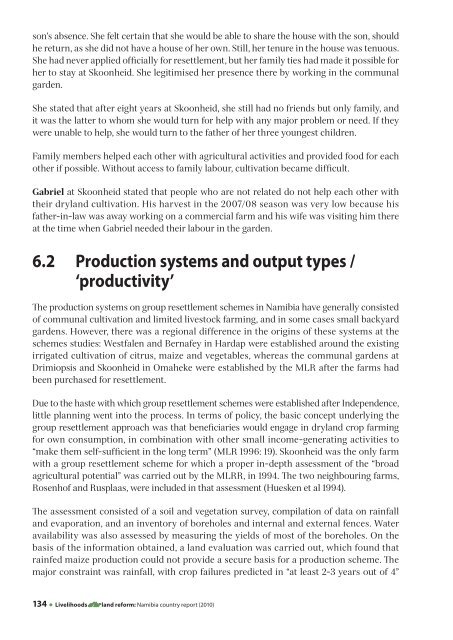Namibia country report
Namibia country report
Namibia country report
- No tags were found...
Create successful ePaper yourself
Turn your PDF publications into a flip-book with our unique Google optimized e-Paper software.
son’s absence. She felt certain that she would be able to share the house with the son, shouldhe return, as she did not have a house of her own. Still, her tenure in the house was tenuous.She had never applied officially for resettlement, but her family ties had made it possible forher to stay at Skoonheid. She legitimised her presence there by working in the communalgarden.She stated that after eight years at Skoonheid, she still had no friends but only family, andit was the latter to whom she would turn for help with any major problem or need. If theywere unable to help, she would turn to the father of her three youngest children.Family members helped each other with agricultural activities and provided food for eachother if possible. Without access to family labour, cultivation became difficult.Gabriel at Skoonheid stated that people who are not related do not help each other withtheir dryland cultivation. His harvest in the 2007/08 season was very low because hisfather-in-law was away working on a commercial farm and his wife was visiting him thereat the time when Gabriel needed their labour in the garden.6.2 Production systems and output types /‘productivity’The production systems on group resettlement schemes in <strong>Namibia</strong> have generally consistedof communal cultivation and limited livestock farming, and in some cases small backyardgardens. However, there was a regional difference in the origins of these systems at theschemes studies: Westfalen and Bernafey in Hardap were established around the existingirrigated cultivation of citrus, maize and vegetables, whereas the communal gardens atDrimiopsis and Skoonheid in Omaheke were established by the MLR after the farms hadbeen purchased for resettlement.Due to the haste with which group resettlement schemes were established after Independence,little planning went into the process. In terms of policy, the basic concept underlying thegroup resettlement approach was that beneficiaries would engage in dryland crop farmingfor own consumption, in combination with other small income-generating activities to“make them self-sufficient in the long term” (MLR 1996: 19). Skoonheid was the only farmwith a group resettlement scheme for which a proper in-depth assessment of the “broadagricultural potential” was carried out by the MLRR, in 1994. The two neighbouring farms,Rosenhof and Rusplaas, were included in that assessment (Huesken et al 1994).The assessment consisted of a soil and vegetation survey, compilation of data on rainfalland evaporation, and an inventory of boreholes and internal and external fences. Wateravailability was also assessed by measuring the yields of most of the boreholes. On thebasis of the information obtained, a land evaluation was carried out, which found thatrainfed maize production could not provide a secure basis for a production scheme. Themajor constraint was rainfall, with crop failures predicted in “at least 2-3 years out of 4”134 ● Livelihoods after land reform: <strong>Namibia</strong> <strong>country</strong> <strong>report</strong> (2010)
















